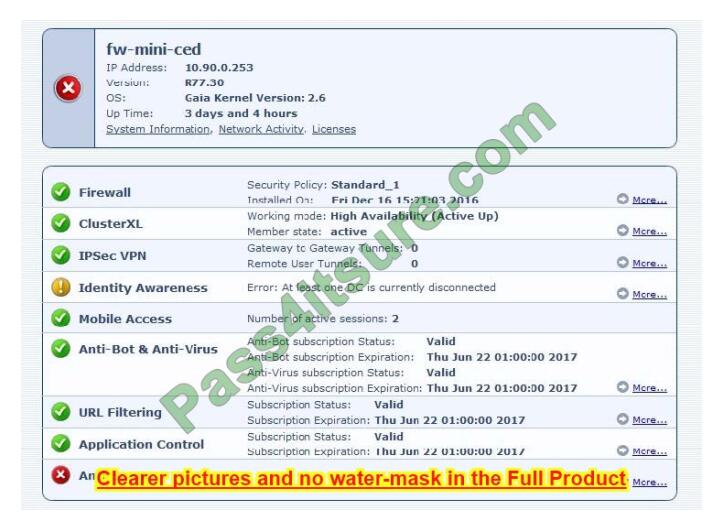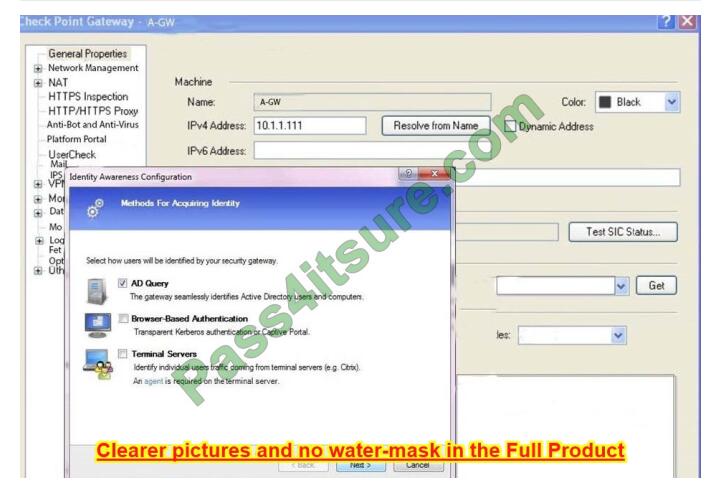Passing the CheckPoint 156-215.81 exam is inseparable from the support of good exam materials. We just updated the 156-215.81 exam dumps and will be the best 156-215.81 exam material you have prepared to help you pass.
It’s easy to get the Pass4itSure 156-215.81 exam dumps up-to-date: https://www.pass4itsure.com/156-215-81.html A new exam material consisting of 535 exam questions and answers ensures that you can successfully pass the CheckPoint 156-215.81 exam.
156-215.81 exam dumps pdf free share: https://drive.google.com/file/d/15a_xyjre-ozeOMA2D9nn1583eRJoX2A-/view?usp=share_link
What is the new CheckPoint 156-215.81 exam?
Exam 156-215.81 is a certified exam for security administrators. Check Point Certified Security Administrator R81 is the industry’s most advanced threat prevention and security management software, delivering uncompromising simplicity and integration across the enterprise.
Test your knowledge areas including:
- Planning and designing a firewall configuration based on business requirements
- Implementing firewall policies within networks or complex network segments
- Monitoring network traffic to identify malicious activity
- Maintaining security posture by updating software versions (including patches)
Looking for better resources and exam materials for the CheckPoint 156-215.81 exam?
To prepare for the 156-215.81 exam pass, now use the Pass4itSure 156-215.81 exam dumps containing the most powerful exam materials. Best 156-215.81 exam study materials and exercises at Pass4itSure.
The purpose of the 156-215.81 exam dumps is to help you pass the exam and gain the knowledge and skills you need to become a certified security administrator.
Where can I find free 156-215.81 exam questions? (the latest version of)?
Rest assured, you are in the right place. Easyhometraining.com blog provides you with free 156-215.81 exam questions, which are read below.
156-215.81 Free Exam Dumps Questions
NEW – QUESTION 1
What does it mean if Deyra sees the gateway status: Choose the BEST answer.

A. SmartCenter Server cannot reach this Security Gateway
B. There is a blade reporting a problem
C. VPN software blade is reporting a malfunction
D. Security Gateway\\’s MGNT NIC card is disconnected.
Correct Answer: B

Reference: https://sc1.checkpoint.com/sc/SolutionsStatics/NEW_SK_NOID1493612962436/ active1704302237.fw.png
NEW – QUESTION 2
In what way are SSL VPN and IPSec VPN different?
A. SSL VPN is using HTTPS in addition to IKE, whereas IPSec VPN is clientless
B. SSL VPN adds an extra VPN header to the packet, IPSec VPN does not
C. IPSec VPN does not support two factor authentication, SSL VPN does support this
D. IPSec VPN uses an additional virtual adapter, SSL VPN uses the client network adapter only
Correct Answer: D
NEW – QUESTION 3
Fill in the blanks: A security Policy is created in _________ , stored in the _________ , and Distributed to the various __________ .
A. Rule base, Security Management Server, Security Gateways
B. SmartConsole, Security Gateway, Security Management Servers
C. SmartConsole, Security Management Server, Security Gateways
D. The Check Point database, SmartConsole, Security Gateways
Correct Answer: C
NEW – QUESTION 4
On the following picture an administrator configures Identity Awareness:

After clicking “Next” the above configuration is supported by:
A. Kerberos SSO which will be working for Active Directory integration
B. Based on Active Directory integration which allows the Security Gateway to correlate Active Directory users and machines to IP addresses in a method that is completely transparent to the user
C. Obligatory usage of Captive Portal
D. The ports 443 or 80 what will be used by Browser-Based and configured Authentication
Correct Answer: B
To enable Identity Awareness:
1. Log in to R80 SmartConsole.
2. From the Gateways and Servers view, double-click the Security Gateway on which to enable Identity
Awareness.
3. On the Network Security tab, select Identity Awareness. The Identity Awareness Configuration wizard opens.
4. Select one or more options. These options set the methods for acquiring identities of managed and
unmanaged assets. AD Query – Lets the Security Gateway seamlessly identify Active Directory users and computers.
Browser-Based Authentication – Sends users to a Web page to acquire identities from unidentified users. If Transparent Kerberos Authentication is configured, AD users may be identified transparently. Terminal Servers – Identify users in a Terminal Server environment (originating from one IP address).
NEW – QUESTION 5
Joey wants to configure NTP on R80 Security Management Server. He decided to do this via WebUI. What is the correct address to access the Web UI for Gaia platform via browser?
A. https://
B. https://:443
C. https://:10000
D. https://:4434
Correct Answer: A
Access to Web UI Gaia administration interface, initiate a connection from a browser to the default administration IP address: Logging in to the WebUI Logging in To log in to the WebUI:
1. Enter this URL in your browser: https://
2. Enter your user name and password.
NEW QUESTION 6
In SmartEvent, what are the different types of automatic reactions that the administrator can configure?
A. Mail, Block Source, Block Event Activity, External Script, SNMP Trap
B. Mail, Block Source, Block Destination, Block Services, SNMP Trap
C. Mail, Block Source, Block Destination, External Script, SNMP Trap
D. Mail, Block Source, Block Event Activity, Packet Capture, SNMP Trap
Correct Answer: A
Reference: https://sc1.checkpoint.com/documents/R76/CP_R76_SmartEvent_AdminGuide/17401.htm
NEW – QUESTION 7
Which one of the following is the preferred licensing model? Select the Best answer.
A. Local licensing because it ties the package license to the IP-address of the gateway and has no dependency of the Security Management Server.
B. Central licensing because it ties the package license to the IP-address of the Security Management Server and has no dependency of the gateway.
C. Local licensing because it ties the package license to the MAC-address of the gateway management interface and has no Security Management Server dependency.
D. Central licensing because it ties the package license to the MAC-address of the Security Management Server Mgmtinterface and has no dependency of the gateway.
Correct Answer: B
Central License A Central License is a license attached to the Security Management server IP address, rather than the gateway IP address. The benefits of a Central License are:
1. Only one IP address is needed for all licenses.
2. A license can be taken from one gateway and given to another.
3. The new license remains valid when changing the gateway IP address. There is no need to create and install a new license.
NEW – QUESTION 8
A client has created a new Gateway object that will be managed at a remote location. When the client attempts to install the Security Policy to the new Gateway object, the object does not appear in the Install On check box. What should you look for?
A. Secure Internal Communications (SIC) not configured for the object.
B. A Gateway object created using the Check Point > Externally Managed VPN Gateway option from the Network Objects dialog box.
C. Anti-spoofing not configured on the interfaces on the Gateway object.
D. A Gateway object created using the Check Point > Secure Gateway option in the network objects, dialog box, but still needs to configure the interfaces for the Security Gateway object.
Correct Answer: B
NEW – QUESTION 9
When should you generate new licenses?
A. Before installing contract files.
B. After an RMA procedure when the MAC address or serial number of the appliance changes.
C. When the existing license expires, license is upgraded or the IP-address where the license is tied changes.
D. Only when the license is upgraded.
Correct Answer: B
NEW – QUESTION 10
Which message indicates IKE Phase 2 has completed successfully?
A. Quick Mode Complete
B. Aggressive Mode Complete
C. Main Mode Complete
D. IKE Mode Complete
Correct Answer: A
NEW – QUESTION 11
You are unable to login to SmartDashboard. You log into the management server and run #cpwd_admin
list with the following output:

What reason could possibly BEST explain why you are unable to connect to SmartDashboard?
A. CDP is down
B. SVR is down
C. FWM is down
D. CPSM is down
Correct Answer: C
The correct answer would be FWM (is the process making available communication between
SmartConsole applications and Security Management Server.). STATE is T (Terminate = Down)
: Symptoms SmartDashboard fails to connect to the Security Management server.
1. Verify if the FWM process is running. To do this, run the command: [Expert@HostName:0]# ps -aux | grep fwm
2. If the FWM process is not running, then try force-starting the process with the following command:
[Expert@HostName:0]# cpwd_admin start -name FWM -path “$FWDIR/bin/fwm” -command “fwm”
Reference: https://supportcenter.checkpoint.com/supportcenter/portal?
eventSubmit_doGoviewsolutiondetails=andsolutionid=sk97638 https://supportcenter.checkpoint.com/
supportcenter/portal?eventSubmit_doGoviewsolutiondetails=andsolutionid=sk12120
NEW – QUESTION 12
In which deployment is the security management server and Security Gateway installed on the same appliance?
A. Bridge Mode
B. Remote
C. Standalone
D. Distributed
Correct Answer: C
Installing Standalone Standalone Deployment – The Security Management Server and the Security Gateway are installed on the same computer or appliance.

NEW – QUESTION 13
Where would an administrator enable Implied Rules logging?
A. In Smart Log Rules View
B. In SmartDashboard on each rule
C. In Global Properties under Firewall
D. In Global Properties under log and alert
Correct Answer: B
For more information, about CheckPoint 156-215.81 exam dumps: https://www.pass4itsure.com/156-215-81.html